Whether you’re a birder, a photography enthusiast, or a history buff who wants to retrace Charles Darwin’s footsteps—or all three—a trip to the Galápagos ranks high on most travelers’ must-see destinations. Since the archipelago’s famous wildlife is abundant and active year round, close-up encounters with blue-footed boobies, sea lions, and giant tortoises are basically guaranteed.
However, the experience as a whole will be even more enjoyable if you come prepared. Keep in mind that each Galápagos cruise has different on-board offerings and shares varied packing lists, so it’s best to check with your outfitter before you go to see what it includes. Here’s what I learned on my 10-day expedition cruise to the Galápagos with Lindblad Expeditions–National Geographic.
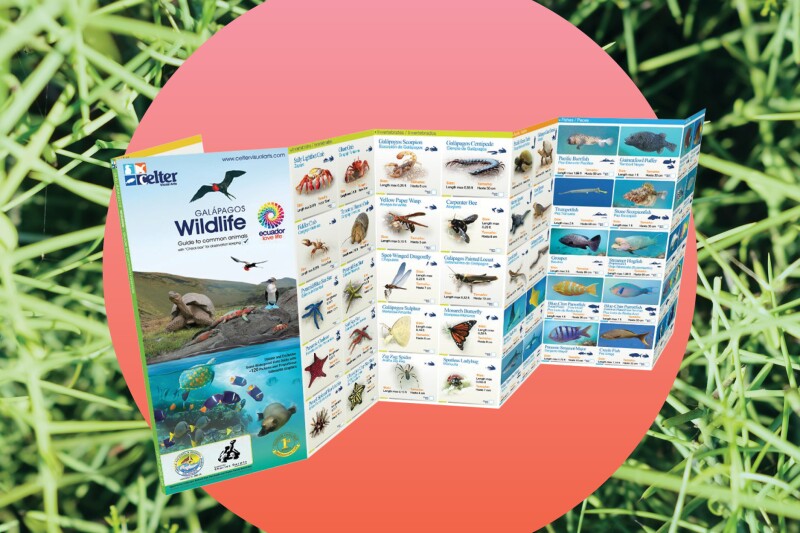
A field guide will help you spot wildlife during your trip.
Courtesy of Amazon, Design by Emily Blevins, Lyndsey Matthews
Brush up on your Darwin: Books to read before visiting the Galápagos
Lindblad provided a reading guide before my departure with six essential reads, 12 additional recommended books (as well as nine books suited for younger guests going along for the journey). Only the most avid readers will make it through all 18 items on the reading list, so don’t sweat it; focus on the basics so you at least arrive with some context.
- The Galápagos portion of Charles Darwin’s Voyage of the Beagle—the travelogue of his five-year journey—is only about 20 pages, so this is the best place to start. Published in 1839, it still provides a solid introduction to the islands and the animals you’ll encounter.
- For a comprehensive guide to the archipelago, Michael H. Jackson’s Galápagos: A Natural History gives a wide overview to the area’s geology, plants, and animals.
- To take a deep dive into Darwin’s theory, The Beak of the Finch is the Pulitzer Prize–winning story of how two scientists, Peter and Rosemary Grant, studied the finches of Daphne Major island and discovered that evolution can be seen in real time.
- If you’re more into fiction, Kurt Vonnegut’s Galápagos is a fun—not entirely reality-based—read.
- To identify and keep track of the dozens of species of animals you’ll spot on land and in the water, pick up a photographic field guide to keep in your backpack. The Galápagos Wildlife Field Guide is not only made from durable, splash-proof material but also is written by Celso Montalvo, a certified naturalist who is part of the Lindblad Expeditions team in the Galápagos.
Bring more sunscreen than you think you’ll need
Buy Now: Australian Gold Botanical SPF 70 Sunscreen, $18, australiangold.com
The sun is strong on the equator, and you’ll need more sunscreen than you’d think. The three-ounce bottle I packed ran dry two days before the trip ended, leaving me grateful to my friend Kathrine, who checked an eight-ounce bottle in her suitcase. You’ll be reapplying multiple times per day, so it’s worth bringing a bigger bottle and checking your bag. I’ve tried more than half a dozen reef-safe, non-chemical titanium dioxide and zinc oxide sunscreens, and I’ve found that Australian Gold Botanical Sunscreen goes on without leaving chalky-white marks on my clothes and has a more matte and less greasy finish compared to other mineral sunscreens.
Consider packing sun protection clothing
Buy Now: Columbia PFG Tamiami II Long Sleeve Shirt, $50, columbia.com
If you don’t want to be subjected to packing more liquids than can fit in a carry on, take a tip from the Ecuadorian crew and cover yourself with clothes instead of sunscreen. On the hottest days, they all wore large-brimmed hats (more on that below), buffs to cover their necks and lower faces, long-sleeved shirts and pants, and even fingerless gloves.
Among the passengers, Columbia Performance Fishing Gear with built-in ultraviolet protection factor (UPF) seemed to be the shirts of choice for both men and women.
Same goes for swim gear
For snorkeling, Lindblad issues short wetsuits that provide warmth and extra buoyancy during deep water excursions (check to see if your cruise line also does this). You’ll also want to pack a long-sleeve swimsuit (or rashguard to wear over your suit) to protect your skin from the sun when snorkeling in warmer, shallower waters just off the beach. Because you’ll be in the water every day, pack at least two suits so one can dry out while you wear the other one.
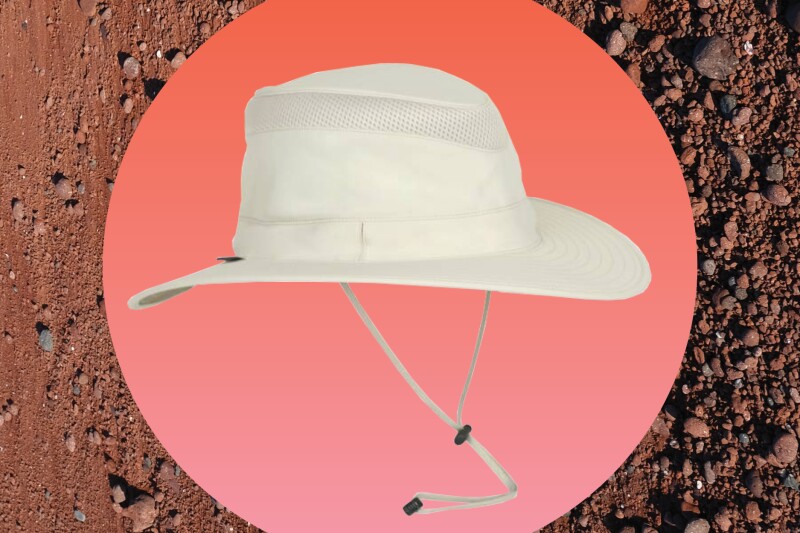
Don’t let a sunburn spoil this once-in-a-lifetime journey. Wear a hat.
Courtesy of Sunday Afternoons, Design by Emily Blevins, Lyndsey Matthews
Don’t forget to pack a hat (and sunglasses!)
Buy Now: Sunday Afternoons Charter Hat, $52, backcountry.com
I wore a baseball hat that kept my face sunburn-free for the entire trip. However, if I were to do it again I would bring a hat with a chin strap to prevent it blowing off while zipping around on the Zodiac boats and a brim to protect the back of my neck from the sun.
The gift shop on board the National Geographic Endeavor II sold broad-brimmed hats with the ship’s name on them, which makes for a nice souvenir. If you want to arrive prepared, Sunday Afternoons‘s Charter Hat includes all of the features mentioned above, plus it packs flat, comes with holes in the top to keep your sunglasses in place, and is available in multiple sizes suitable for men and women. Be sure not to forget sunglasses—a polarized pair is key to reduce glare from the water’s surface.
Bring deep conditioner
Buy Now: Olaplex No. 5 Bond Maintenance Conditioner, $14, nordstrom.com
You will be in salt water multiple times a day and your hair (and your stylist) will thank you for bringing a deep conditioner along. Each day after snorkeling, I’d shower and then drench my hair in Olaplex No. 5 Bond Maintenance Conditioner—which comes in a TSA friendly 3.3-ounce size—and leave it in for the rest of the afternoon.
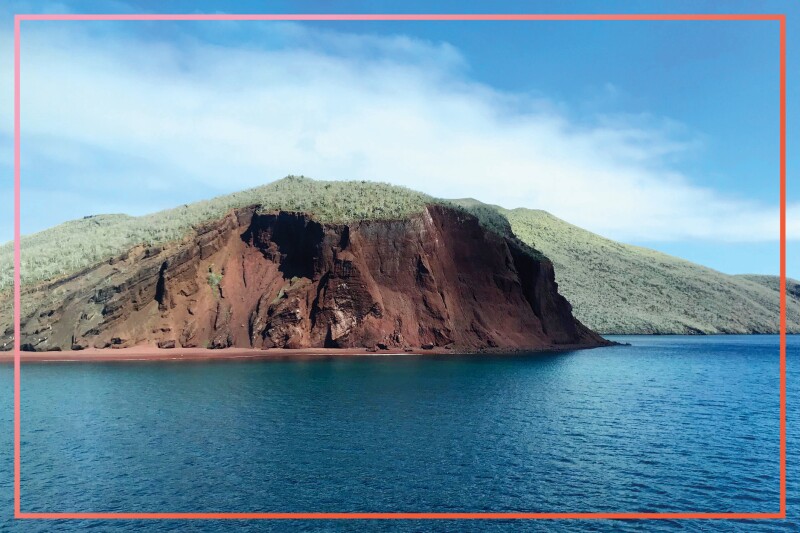
Snorkeling off the shore of Rábida Island, it’s likely you’ll come across sea turtles, parrotfish, and sea lions.
Photo by Lyndsey Matthews, Design by Emily Blevins
You don’t need to bring snorkeling gear, but you’ll want antibacterial wipes
Buy Now: Care Touch Alcohol-Free Sanitizing Wipes, $17 for 10 travel packs, amazon.com
Most boats will provide snorkeling gear for daily outings. If you’re the least bit germaphobic, be sure to pack antibacterial wipes to sanitize the mouthpiece before you use it. Throw them in your carry-on and keep them there for future travels—they’re also useful for wiping down dirty tray tables on airplanes and hotel-room remote controls.
Bring Febreze to freshen up clothes... or just pack more
Buy Now: Febreze Fabric Refresher Travel Size 3-Pack, $8, amazon.com
In late April, it wasn’t that hot. Most days, the high was about 82 degrees Fahrenheit. But the humidity will make you sweat a lot. After the first day’s short hike, the one UPF shirt I had packed was ripe. The schedule most days included a morning hike, afternoon snorkel, and another hike before sunset. Unless you don’t mind changing back into clothes you’ve sweated in already, bring several shirts and pairs of underwear for each day.
Most ships have laundry on board, but it’s not included in the trip price. Even if you’re a devout carry-on only traveler like me, the bigger suitcase is worth it. Fortunately, on a Galápagos cruise, you won’t need anything fancier than T-shirts and jeans for dinner on board.
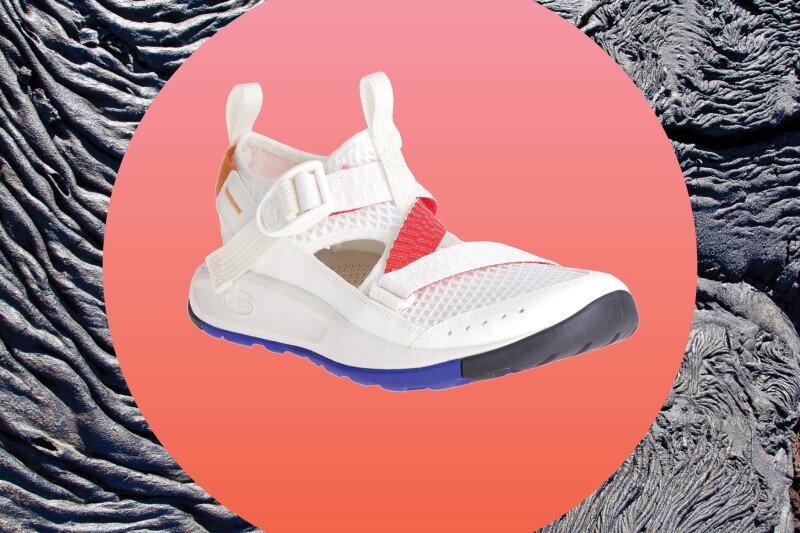
Make sure your water sandles also provide traction for slippery rocks.
Courtesy of Chaco, Design by Emily Blevins, Shutterstock
Consider closed-toe sport sandals
Buy Now: Chaco Odyssey Sandal, from $55 (was $100), nordstromrack.com; rei.com
After carefully considering the packing list—and my willingness to buy new, extra dorky shoes—I packed three pairs: New Balance trail runners for dry landings, Tevas for wet landings, and Birkenstocks for on board the ship. I wore all three most days, but I could have gotten away without the trail runners since we had to wade through water pretty much every time we went ashore. However, I earned the “worst injury of the week” title from the ship’s doctor by slipping and cutting my knees on sharp rocks on Santiago Island, so I can vouch for the need for shoes with more traction than basic Tevas.
You can handle the hikes
My fellow passengers ranged in age from six to 80. As long as long as you’re comfortable being in the water for an hour or so and walking a bit longer than that, the hikes and snorkel excursions aren’t too strenuous. Most days included a 90-minute, relatively flat hike in the morning with lots of stops. Then it was back to the boat to change into our wetsuits for about an hour of deep-water snorkeling followed by lunch and a nap break. In the late afternoon, we’d take a shorter walk or a Zodiac along the cliffs. Each excursion is optional, and you’ll be briefed by the expedition leader beforehand about what to expect. For the most active travelers, on most days there was also time to use the ship’s kayaks and stand-up paddleboards.
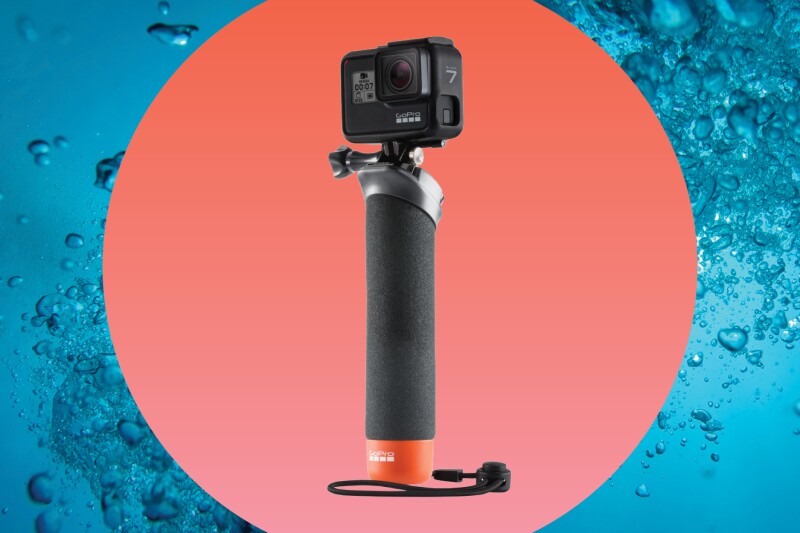
GoPro Hero 7 Black cameras are waterproof down to 33 feet.
Courtesy of GoPro, Design by Emily Blevins, Shutterstock
You’ll want an underwater camera
Buy Now: GoPro Hero 7 Black, $400, gopro.com
If you’ve ever considered buying a GoPro for underwater video, this is definitely the trip for it. It’s likely that you’ll make friends on board with someone who has one and is willing to share his or her footage with you. But you may regret not having your own the moment two sea lions swim right up to your face. Remember to recharge the battery before you head out on a 45-minute snorkeling trip. GoPros are waterproof down to 33 feet, and you’ll want to pick up a floating hand grip that will bring the camera back to the surface if you drop it in the water.
Pack that 400mm lens
An iPhone will suffice for casual photographers in the Galápagos, since the wildlife there really is as fearless as people say. (You’ll often struggle to maintain the six-foot boundary that naturalists enforce as curious sea lion pups and nearly-blind giant tortoises cross your path.) If you’d like to get really close-up shots, bring a telephoto lens. I rented a Fuji 100-400mm lens for my Fujifilm X-T30 camera for 11 days from lensrentals.com for about $200. To buy it from B&H Photo would have set me back $1,900.
With that lens, I got shots like this:

A long zoom lens allowed me to capture this portrait of a young sea lion without breaking any national park rules.
Photo by Lyndsey Matthews, Design by Emily Blevins
A waterproof day bag of some sort is crucial
Buy Now: Arkadia Packable Waterproof Backpack, $67 (was $90), arkadiasupply.co
If you’re bringing a larger camera on excursions, you’ll want to keep it protected in a waterproof camera backpack since it’s likely you’ll get splashed on the Zodiac rides to shore. If you just need to bring your iPhone and some extra sunscreen along, a smaller hip pack (so you sweat less on your back) or lightweight day pack will be sufficient.
A word on seasickness . . .
Pack Dramamine, or some sort of motion sickness medication for your evenings on board, just in case. And if you tend to get extreme seasickness, talk to a doctor about getting a prescription for a Transderm Scop patch. Galápagos ships are relatively small—they carry at most 100 passengers—so you’ll feel the movement of the ocean a lot more than you would on a large cruise ship.
From January to June, the waters tend to be calmer. The ocean starts to become rougher in July and is at its choppiest between August and October. I’m fairly prone to motion sickness, and I only needed to take Dramamine two days out of my 10-day cruise in late April.
The best time of year to go is . . .
The Galápagos’s location at the equator means the air temperature doesn’t vary much throughout the year. January to June is considered to be the rainy season, but showers don’t last very long, and the water temperature is higher during these months—the average hovers between 74 and 76 degrees Fahrenheit. As mentioned earlier, the ocean is also calmer during this time of year, making it a better option for those prone to seasickness. April and May are also the ideal times to see blue-footed boobies and frigatebirds perform their elaborate mating rituals.
During the dry season between July and December, colder currents bring water temperatures in the 60s and choppier seas. They also bring higher levels of nutrients to the water, which means more fish and better snorkeling, plus more migratory birds.
A note on sustainability
Exploring the archipelago by boat can be a more sustainable way to see it because of how tightly the Ecuadorian government regulates the cruise industry in the Galápagos. In addition to capping the capacity of boats at 100 passengers, the number of cruise ships is also limited in the Galápagos to fewer than 100 boats. In general, land-based tourism is less regulated by the national park. According to the New York Times, more than 90 percent of the rise in visitor growth to the island from 2007 to 2016 is from land-based tourism, which is putting more stress on the populated parts of the islands.
The national park also tightly organizes the schedule of where and when each ship is allowed to bring passengers onto the islands, which means on most shore excursions you’ll only see other passengers from your boat and you’ll never feel like it’s overrun with tourists. In addition to offsetting 100 percent of the emissions from its cruise ships in the Galápagos, Lindblad also raises money through the Lindblad Expeditions–National Geographic (LEX-NG) Fund to support a number of community projects. One funds a local school and another trains artisans to turn paper waste and glass into jewelry and artwork that is sold in gift shops on board.
How to decide which ship is best for you
When it comes to picking a cruise, you can select from about half a dozen lines that operate small, medium-size, and large ships.The large ships that can accommodate up to 100 passengers are able to provide more luxurious amenities, like spas and gyms, as well as glass-bottomed boats. In addition to the 100-passenger Celebrity Flora that debuted in June 2019, Silversea is following with another all-suite ship of the same size—Silver Origin—in July 2020. Both ships were custom-built for the destination and designed with the newest technology to make them as sustainable as possible.
Small ships won’t have spacious rooms and as many luxury amenities, but fewer people means fewer lines for boarding Zodiacs and at the breakfast buffet. Quasar Expeditions and Ecoventura both operate ones with capacity as low as 18 passengers.
Mid-size ships (around 20-50 passengers) offer a happy medium between the two. Lindblad Expeditions has the 48-passenger National Geographic Islander, Quasar has the 32-guest M/V Evolution, and Ecuador’s own Metropolitan Touring has the 48-guest Yacht La Pinta and the 40-guest Yacht Isabela II.
I sailed with Lindblad Expedition–National Geographic on the 96-passenger National Geographic Endeavor II. Lindblad’s two boats are not as new (National Geographic Endeavor II was last retrofitted in 2016) or as luxe as some of the other major lines’ boats, but the company has decades of experience, having operated expedition cruises in the Galápagos since 1967. Lindblad pioneered a program with Ecuador’s department of agriculture to work with local farmers in the Galápagos to source produce, chicken, and fish for its ships, which also serve Ecuadorian beer and wine.
Our ship was nearly at capacity, yet I never waited more than a few minutes to board a Zodiac. And I made friends with several different groups of people on board. Our ship had six naturalists who were all were certified by Galápagos National Park, and they were extremely knowledgeable. We weren’t assigned guides, so we could switch for each hike or snorkeling excursion or stick with our favorites.
All travel courtesy of Lindblad Expeditions–National Geographic.
>>Next: Scientists Spill About the Best Places to See Sharks Around the World











